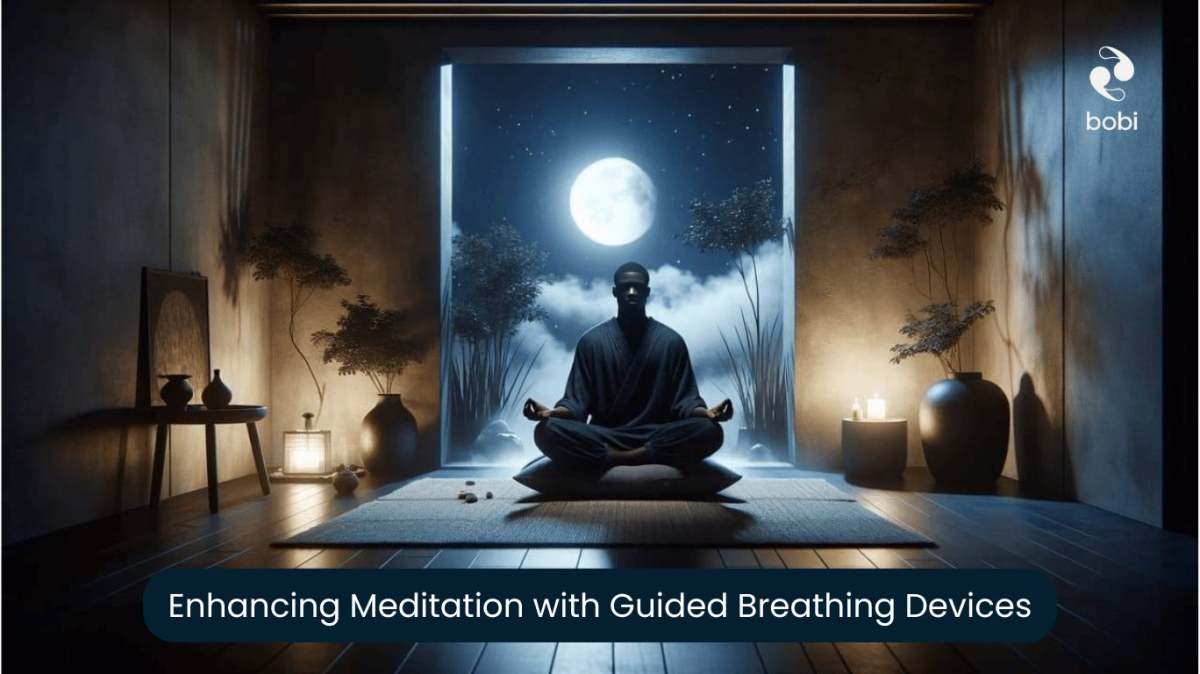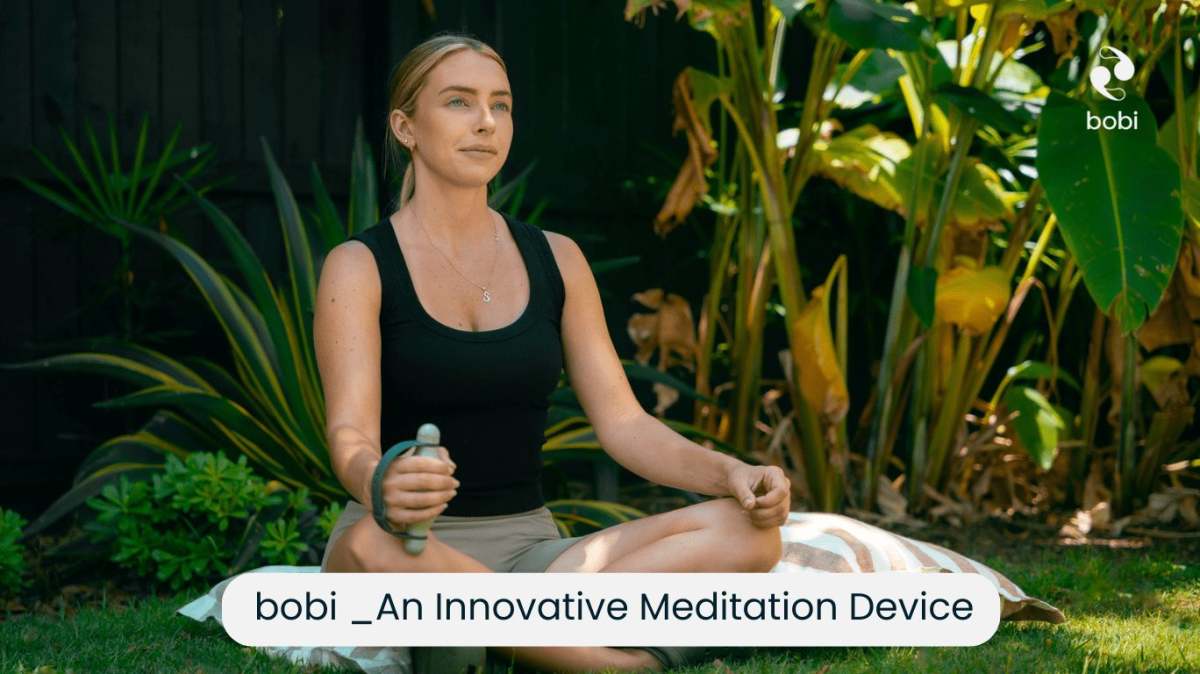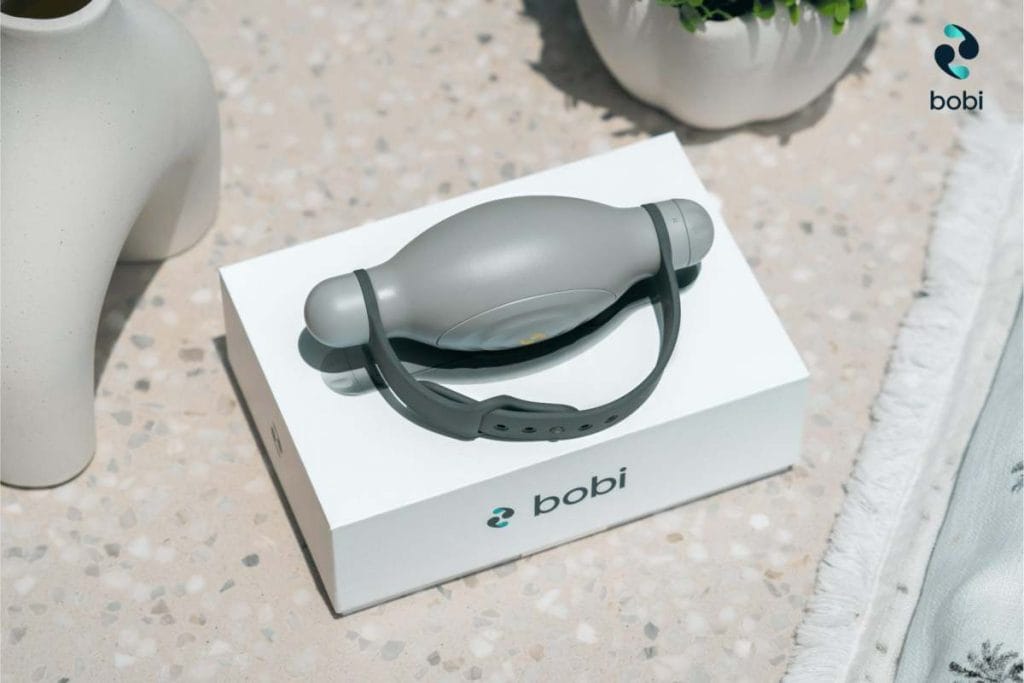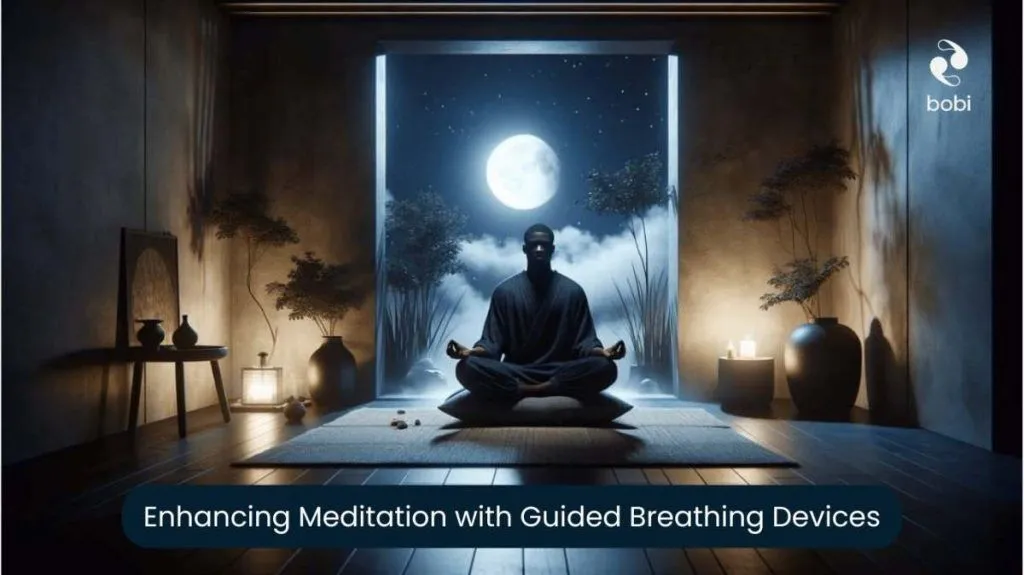
It is true that anxiety, stress, detachment, and fear generated by either wars or natural calamities like COVID-19 cause a society-wide mental toll. When you feel anxious or stressed, you think you cannot breathe properly, and experience more speedy and shallow breathing. Nowadays, instead of medication people are siding with meditation to revive the equilibrium of their lives.
At the heart of meditation is the guided breathing. However, many people find it difficult to maintain concentration and attain deep relaxation. This is where guided breathing devices can be incredibly helpful. Guided breathing devices are devices that improve meditation exercises by guiding people to adjust their breathing patterns more efficiently.
In today’s post, we’ll delve into how guided breathing devices can boost your meditation practice, the types of devices at hand, and the role of technology in molding the future of mindfulness.
Key Highlights
- Guided breathing devices help you breathe at a preferred rate. They give feedback on how you breathe so you can have slower breaths while meditating.
- Studies show that using these devices can lower blood pressure, which is good for people with hypertension.
- Using these devices with yoga and music therapy can make your meditation more effective and enjoyable.
- Some people worry that these devices will take the place of traditional meditation. It’s understandable, but they actually support and improve the current practices rather than replace them.
- For the best results, aim for 10 to 15 minutes of guided breathing practice, about 3 to 4 times a week.
Benefits of Guided Breathing for Meditation
Do you know what turns meditation into effective meditation? Well, it is ‘Breathing’. Breathing is the foundation of successful meditation. At the center of good meditation is controlled breathing. In fact, certain breathing practices are used to decrease stress, soothe the mind, and increase concentration.
Slow breathing is key in many meditation practices. It means taking fewer breaths each minute on purpose. This simple act can cause your body to respond well. According to research, engaging in slow conscious breathing activates the parasympathetic nervous system and boosts heart rate variability (HRV), an indicator of physiological strength. It also helps lower blood pressure.
Guided breathing devices go a little further in this approach by offering actual feedback and assistance, making sure that your breathing gets the most out of your meditation practice.
When you take slow, deep breaths with a guided breathing device, your body relaxes. Relaxation helps your autonomic nervous system. This system controls important things like heart rate and blood pressure.
Types of Guided Breathing Devices for Meditation
There’s a variety of guided breathing devices available in the market today. Every device presents special features designed for distinct meditation needs. These devices are introduced to help improve your meditation. Having a better comprehension of these choices will help you select a perfect tool for your meditation exercise.
- Wearable Devices: Wearables like smartwatches and professional meditation bands, detect your breathing rhythms and offer actual feedback. Others provide light vibrations or visual signals to assist the breath. This makes sure you stay concentrated during your meditation.
- Handheld Devices: Another type of guided breathing device is the one made to grip the hand during a meditation session. They mostly have fixed sensors that monitor breathing patterns and offer advice via sounds, lights, and vibrations. Handheld tools are especially functional for the ones who favor tangible feedback during the exercise.
- App-Based Devices: Several guided breathing devices are combined with mobile apps, letting individuals follow their improvement with time. The apps mostly involve breathing techniques, guided meditation sessions, and individualized tips to enhance your exercise. This ease of enjoying all these attributes in one place makes app-based devices a famous option for techie meditators.
- Stationary Devices: Stationary devices are far from handles and wearables. These devices are intended to be settled in a specified setting like a bedside table or meditation area. The tools frequently utilize soundscapes, atmospheric light, or aromatherapy to assist your breathing and develop soothing surroundings for meditation.
Biofeedback is an important feature in many of these devices. It removes the guesswork from breathing exercises. By seeing or hearing your breathing pattern, you learn more about how your body reacts. This awareness helps you gain better control and achieve deeper relaxation.
The Role of Technology in Meditation and Mindfulness
It was found that about 200-500 million people engage in meditation globally. The mix of technology and mindfulness has raised some questions. Some people worry that devices may interfere with a practice that is all about simplicity. However, a fusion of technology and meditation has only ensured that it is more approachable to many. Moreover, if we see technology as a helpful tool instead of a distraction, we can have a more balanced view.
How Technology Is Shaping Our Meditation Practices
The incorporation of technology into meditation sessions has transformed how we address mindfulness. At the frontline of this change are guided breathing devices, providing a blend of classic meditation exercises with contemporary technological developments.
Meditation Apps & Devices:
The rise in meditation apps shows how technology is helping us find mindfulness. These apps provide guided meditations, breathing exercises, and tools to track progress. This makes it easier for people to practice mindfulness and stay interested.
Reviews of many studies show that guided breathing, often supported by technology, can help reduce stress and improve emotional control.
Research keeps looking into how effective technology is in mindfulness practices. Early results say these devices can help people relax and pay better attention. As technology improves, we will likely see better devices and apps that give personalized ways to meditate.
But we need to use technology mindfully. While these tools can be helpful, they shouldn’t replace the need to connect with ourselves. It is important to balance using technology with the main ideas of mindfulness. This way, we can enjoy the benefits of modern tech without losing our focus on self-awareness.
The Future of Meditation: Trends and Predictions
As technology constantly evolves, so will the gadgets accessible for meditation. Exciting new technology is changing how we can meditate.
1. Artificial Intelligence (AI)
One such arising craze is the utilization of Artificial Intelligence (AI) in guided breathing devices. AI can examine a person’s breathing rhythm in reality, providing more exact and customized guidance.
2. Virtual Reality (VR)
Virtual Reality (VR) is another field certain to alter meditation practices. VR meditation sessions can involve people in relaxed surroundings, improving the meditative experience. A blend of guided breathing devices and VR allows individuals to attain a great sense of relaxation and mindfulness.
We need additional studies to understand the long-term effects. Early research shows these tools may help reduce stress, improve focus, and boost emotional health. It’s also important to tackle the high risk of bias in studies tied to these devices to get trustworthy results.

Integrating Guided Breathing Devices into Your Meditation Routine
Incorporating a breathing device into your daily practice is easy. Follow these steps for an effective experience:
- Find a Comfortable Space: First, find a quiet and comfortable spot where you can relax without interruptions.
- Select the Right Device: Choose a device that feels right for you and learn how it works.
- Short Sessions: Start with short sessions and slowly increase the time as you feel more at ease.
- Focus: During your guided breathing meditation, pay attention to how each inhalation and exhalation feels. Notice how the device helps you take slower and more controlled breaths.
- Consistency: With regular practice, you can see the beneficial effect it has on your relaxation, lower stress levels, and an increased sense of well-being.
Creating a Conducive Environment for Meditation with Devices
To make the best use of guided breathing devices, it’s crucial to create a good space for your meditation practice. A place that is free from distractions and noise helps you relax more and think clearly. Keeping the temperature comfortable, lowering the lights, and using scent diffusers can also make your experience better.
Think about adding things that bring calmness, like soothing nature sounds or gentle music. These sounds can help clear your mind, making it easier to focus on your breath and relax deeply. Moreover, lighting has a critical impact on meditation episodes. So, try using dim, discrete lighting that goes with a guided breathing device.
By focusing on comfort and making your space peaceful, you help yourself breathe better and connect with your inner self.
Advanced Techniques for Experienced Meditators
For people who already know about meditation, guided breathing devices can help you go deeper into the practice. You can change the settings to try different ways of breathing. Some examples are box breathing and alternate nostril breathing.
Using the device along with advanced visualization methods or mantra meditation can help you reach deep awareness and explore yourself. It’s important to take your time with new techniques and listen to how your body feels.
Combining Guided Breathing with Other Meditation Forms
If you’re a seasoned meditator, you can combine guided breathing devices with additional meditation forms to intensify your practice. Here are some other meditation forms with which you can combine guided breathing.
Mindfulness Meditation:
You can incorporate guided breathing with mindfulness meditation, concentrating on the feelings of each breath _ to its natural pattern and flow and the way it senses on each inhale and exhale. In this practice, you stay conscious of your emotions and thinking. This blend improves your capability to ground yourself in the present and lowers the likelihood of a mind stroll. Guided breathing is a primary yet very powerful mindfulness meditation technique.
Yoga:
Guided breathing devices can be used in many other mindfulness activities. For example, include your device when you do yoga. It is an ideal choice to improve your mind-body connection by matching your breath with each yoga movement. This way, you can get more benefits from both yoga and the breathing device.
Music Therapy:
Music therapy is also a nice way to support guided breathing meditation. You can pick calm music or nature sounds that make you feel good. These soothing sounds can help you relax more. It can feel very calm and good for your mind by combining your rhythmic breathing with these melodies.
Walking Meditation:
Using breathing devices during walking meditation is another way to keep a steady breathing pattern. Even if you’re walking from your car to the store or around the neighborhood, you can roll it into a meditative session. This can help deepen your mindfulness practice. Whether you want to improve what you already do or try something new, guided breathing devices offer many ways to explore mindfulness.
Exploring Deep Meditation States with Devices
Guided breathing devices can work exceptionally for traversing deep meditation states. Experienced meditators can use guided breathing devices to reach deeper levels of meditation. They can slow down their breathing exercises and take longer exhales. This practice helps you relax more, leading to a slower heart rate and quieter thoughts. It allows for better self-reflection and increased awareness.
Some advanced devices provide breathing patterns based on your heart rate variability (HRV). This makes your practice better for reaching those deeper meditation states. These devices take biofeedback to check how your body responds and adjust the breathing exercises for your needs. This helps with relaxation.
It’s important to take these advanced techniques slowly and listen to your body. The aim is to explore your meditation practice deeper at the right pace. Seek advice from skilled meditation teachers if you need help.
bobi – Your Personal Innovative Meditation Device

bobi is an innovative meditation tool designed by a psychologist, Damien Thomas, with over 20 years of experience in the field. This advanced device pulls the modern biofeedback technology to assist individuals towards optimal breathing rhythms, crucial for deep and successful meditation. The tangible feedback system of bobi makes sure that your breath stays balanced and constant.
This allows you to remain concentrated and peaceful throughout your meditation practice. Moreover, the portability of the tool guarantees effortless incorporation into any setting, even if you’re at work, at home, or on the go. With bobi it is just effortless to attain a state of deep mindfulness and calmness as it guides your breath and provides tactile feedback.
Even if you’re a newbie for meditation or seeking to deepen your exercise, bobi is made to help and pave your way toward better mental health.
The union of modern technology, portability, and user-oriented features makes it a must-have choice for anyone looking to enhance their meditation experience.
Addressing Common Concerns and Misconceptions
Let’s explore some of the common concerns and misconceptions related to guided breathing devices and meditation.
Are Guided Breathing Devices a Substitute for Traditional Meditation?
A common question is about whether guided breathing devices can replace traditional meditation. It’s good to note that these devices are meant to help improve the practice, not to take its place. Traditional meditation methods, like mindfulness of breath and body scan meditation, focus on awareness through spontaneous breathing and paying attention to body sensations.
Guided breathing devices provide a set way to help people control their breathing. They act like training wheels for newbies, helping them connect with their breath and build the self-discipline needed for traditional meditation. A present study shows that using these devices regularly can lead to better breathing habits, even outside guided sessions.
Whether or not to use these devices in your practice is a personal choice. Some people might find that the structured method helps them be still. Others may enjoy the natural flow of traditional methods more. The important point is that both ways help in developing mindfulness.
Understanding the Limitations and Potential of Devices
While breathing devices can be helpful, it is important to know their limits.
- Dependence on Technology: One limit is that some depend on technology. Things like battery life, software issues, or internet access might sometimes interrupt a session. It’s smart to have a backup plan. Also, think about using traditional methods so you are not relying only on these devices.
- Too Much Reliance on Tools: Another point to think about is not becoming too dependent on these tools. Even though devices can help, they should not take away from building your motivation and self-discipline. Use them as tools to help your mindfulness and meditation journey.
- Time: Lastly, the time needed to see real benefits can be different for everyone. How a person reacts to breathing exercises, how often they practice, and their lifestyle choices all matter. It is important to be patient and to recognize small achievements along the way.
Building a Consistent Meditation Practice with Devices
Consistency is very important for getting the many benefits of meditation. Guided breathing devices can help you build a steady practice with their interactive features and personalized experiences. Many of these devices provide guided sessions that get harder over time, which keeps you motivated and interested.
Setting Realistic Goals and Tracking Progress
To set up a regular meditation exercise with guided breathing tools, it’s crucial to make realistic goals. Starting any new practice should involve realistic goals, and meditation is no different. Begin with shorter sessions and slowly increase the time. This helps your mind and body adjust at a pace that feels good. Try not to set goals that are too high, as they might make you feel discouraged.
Keeping track of your progress through the device’s tracking features can be a strong motivator. It gives you a clear view of your efforts. Many guided breathing devices have built-in tracking features. You can also link them to fitness trackers for a complete data analysis. Watching your consistency, average breathing rate, and even changes in heart rate variability can encourage you.
Remember, the path to mindfulness is personal. It is different for everyone. Focus on your progress and celebrate the achievements along the way. Use the data from your device to improve your practice and enhance your overall well-being.
Overcoming Plateaus and Keeping the Practice Engaging
It’s usual to strike a plateau in your meditation exercise, even with guided breathing devices. One way to get past these plateaus is to change up your practice. You can try different breathing styles like box breathing or alternate nostril breathing.
You could also try guided meditations on themes like gratitude or loving-kindness. Mixing things up helps to engage your brain and makes your practice more interesting.
The key to long-lasting success is continuous involvement with your practice. Remember to pay attention to what your body needs and adjust your practice if necessary. Don’t be afraid to ask for help from experienced meditation teachers or healthcare professionals.
Conclusion
Guided breathing devices are a powerful way to improve your meditation sessions, offering the devices and feedback required to attain profound states of mindfulness and relaxation. using guided breathing devices in your meditation can make your experience much better. These tools help you relax and focus more during meditation. They can benefit both newbies and those who have practiced for a long time by helping them reach deeper meditation states.
As technology changes mindfulness practices, it is important to use these tools thoughtfully. Adding them to your routine can help make your meditation journey more meaningful. Be sure to set clear goals, keep track of your progress, and stay involved for a steady meditation practice with guided breathing devices. If you want effortless yet effective meditation sessions, embrace the power of bobi.

Frequently Asked Questions
1. How do guided breathing devices enhance meditation?
Guided breathing devices help improve meditation. They do this by controlling their breathing rate. This can lower blood pressure and heart rate. It also helps you relax more deeply. As a result, you can have better mindfulness during your practice.
2. Can beginners use guided breathing devices effectively?
Yes, beginners can use guided breathing devices well. Clinical trials show these devices can help people build better breathing habits and start a mindfulness practice.
3. Are there any side effects of using guided breathing devices?
Guided breathing devices often have very few side effects. But some people might feel a little dizzy when they begin using them. It’s important to focus on being comfortable and to breathe naturally. You can change your sessions based on how you feel.
4. How often should I use a guided breathing device in my meditation practice?
For the best results, try to practice deep breathing with the device for 10-15 minutes, 3-4 times a week. Doing this regularly can help improve your stress levels and blood pressure.
5. Can guided breathing devices be used during yoga or other physical activities?
Guided breathing devices are mainly used for meditation. However, they can also enhance yoga and light workouts. These devices help with relaxation and can improve breathing skills. This, in turn, leads to better exercise performance.
Insights from Mindfulness Practitioners
To gather insights from seasoned mindfulness practitioners, we conducted brief interviews with individuals who have integrated guided breathing devices into their practices for an extended period. The present results highlight the subjective experiences and observed benefits reported by these practitioners.
It’s important to acknowledge that these are subjective experiences and may vary based on individual practice and the specific device used. Further research, such as randomized controlled trials, is necessary to validate these anecdotal observations. However, these firsthand accounts provide valuable insights into the potential benefits of guided breathing devices for enhancing mindfulness practices, and addressing diverse needs, from managing attention deficit hyperactivity disorder to aiding in heart failure recovery.




